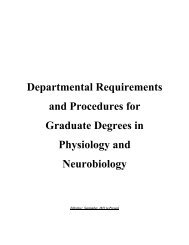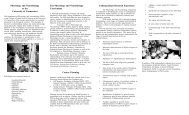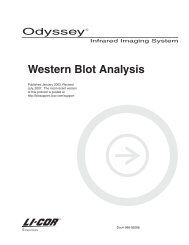Information Brochure (pdf) - Physiology and Neurobiology ...
Information Brochure (pdf) - Physiology and Neurobiology ...
Information Brochure (pdf) - Physiology and Neurobiology ...
You also want an ePaper? Increase the reach of your titles
YUMPU automatically turns print PDFs into web optimized ePapers that Google loves.
The research in my laboratory is aimed at uncovering,<br />
underst<strong>and</strong>ing, predicting, <strong>and</strong> visualizing the<br />
“words” hidden within biological sequence data as<br />
well as disseminating this information to the greater<br />
biological research community. Accomplishing<br />
this task requires a multidisciplinary approach that<br />
integrates computational algorithm development,<br />
experimental method refinement, <strong>and</strong> web-based<br />
software design. As such, sample projects in my<br />
laboratory involve, i) the improvement of the existing<br />
motif-x <strong>and</strong> scan-x web tools for motif extraction<br />
<strong>and</strong> prediction, ii) the development of experimental<br />
assays to decipher enzymatic specificity<br />
at the sequence motif level, <strong>and</strong> iii) the creation of<br />
sequence motif visualization software.<br />
Finally, armed with our knowledge of protein<br />
sequence motifs, my laboratory seeks to use this<br />
information to “read” viral proteomes in an effort to<br />
underst<strong>and</strong> the molecular mechanisms by which<br />
viruses hijack cells, thus leading us closer toward<br />
the goal of developing rationally-designed therapeutic<br />
agents against these important human<br />
pathogens.<br />
Sample sequence motif of the insulin receptor kinase (InsR).<br />
Selected Publications<br />
Schwartz D., Green B., Carmichael L.E., & Parrish C.R. (2002).<br />
The canine minute virus (minute virus of canines) is a distinct<br />
parvovirus that is most similar to bovine parvovirus. Virology 302,<br />
219-23.<br />
Peng J., Schwartz D., Elias J.E., Thoreen C.C., Cheng D.,<br />
Marsischky G., Roelofs J., Finley D., & Gygi S.P. (2003). A<br />
proteomics approach to underst<strong>and</strong>ing protein ubiquitination. Nat<br />
Biotechnology 21, 921-6.<br />
Shimura H., Schwartz D., Gygi S.P., & Kosik K.S. (2004). CHIP-<br />
Hsc70 complex ubiquitinates phosphorylated tau <strong>and</strong> enhances<br />
cell survival. J Biol Chem 279, 4869-76.<br />
Beausoleil S.A., Jedrychowski M., Schwartz D., Elias J.E., Villen<br />
J., Li J., Cohn M.A., Cantley L.C., & Gygi S.P. (2004). Large-scale<br />
characterization of HeLa cell nuclear phosphoproteins. Proc Natl<br />
Acad Sci U S A 101, 12130-5.<br />
Ballif B.A., Villen J., Beausoleil S.A., Schwartz D., & Gygi S.P.<br />
(2004). Phosphoproteomic analysis of the developing mouse<br />
brain. Mol Cell Proteomics 3, 1093-101.<br />
Schwartz D. <strong>and</strong> Gygi S.P. (2005). An iterative statistical<br />
approach to the identification of protein phosphorylation motifs<br />
from large-scale data sets. Nat Biotechnology 23, 1391-8.<br />
Chiang C.W., Derti A., Schwartz D., Chou M.F., Hirschhorn J.N.,<br />
& Wu C.T. (2008). Ultraconserved elements: analyses of dosage<br />
sensitivity, motifs <strong>and</strong> boundaries. Genetics 180, 2277-93.<br />
Schwartz D., Chou M.F., & Church G.M. (2009). Predicting<br />
protein post-translational modifications using meta-analysis of<br />
proteome scale data sets. Mol Cell Proteomics 8, 365-79.<br />
Grimsrud P.A., den Os D., Wenger C.D., Swaney D.L., Schwartz<br />
D., Sussman M.R., Ane J.M., & Coon J.J. (2010). Large-scale<br />
phosphoprotein analysis in Medicago truncatula roots provides<br />
insight into in vivo kinase activity in legumes. Plant Physiol 152,<br />
19-28.<br />
Prisic S., Dankwa S., Schwartz D., Chou M.F., Locasale J.W.,<br />
Kang C.M., Bemis G., Church G.M., Steen H., & Husson R.N.<br />
(2010). Extensive phosphorylation with overlapping specificity<br />
by Mycobacterium tuberculosis serine/threonine protein kinases.<br />
Proc Natl Acad Sci U S A 107, 7521-6.<br />
Schwartz D. <strong>and</strong> Church G.M. (2010). Collection <strong>and</strong> motifbased<br />
prediction of phosphorylation sites in human viruses. Sci.<br />
Signal. 3, rs2.<br />
Ballif B.A., Cao Z., Schwartz D., Carraway K.L., & Gygi S.P.<br />
(2006). Identification of 14-3-3 substrates from embryonic murine<br />
brain. J Proteome Res 5, 2372-9.





